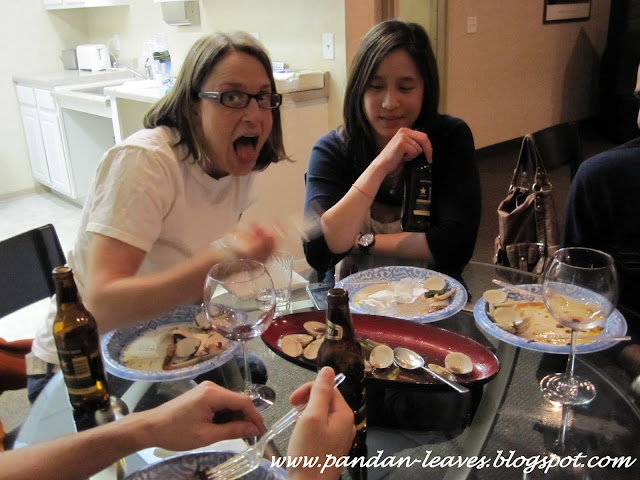The menu includes pineapple fried rice, black hokkien mee (Hey, it's the noodles month. Gotta include noodles, right?), drunken clams, beef rendang, and loh hon guo sweet tea (to wash down the oily food, but we also have wine and beers for that - thanks: Erin, Jane, Raul, and Diana). I figured something tame, with a hint of flair (rendang) is a good start to convert newbies ;)
The reception was good. Although I was a bad host; turned out, Juan is allergic to crustaceans and couldn't eat most of the food (I'm so sorry!). And I should've known better not to put the clams into microwave... oh well. I think the most likable dishes were the beef rendang and black hokkien mee.
At the end of the day, all plates are cleared. Good sign!
waiting for the fashionably late Puerto Ricans!
my fav entourage! proven to be not faint-hearted :)
table manners? what? what!
hmmm..... wine + chinese cooking wine :)
pineapple fried rice
KL black hokkien mee
drunken clams
beef rendang
Pineapple Fried Rice
from Rasa Malaysia
Black Hokkien Mee
Drunken Clams
from Rasa Malaysia
Beef Rendang
from Rasa Malaysia
Loh Hon Guo Sweet Tea
1 loh hon guo
4 oz of dried longans
4 oz of lotus seeds
4 oz of dried red dates
Rock sugar to taste
Wash loh hon guo and lightly crack to open.
Put it into a pot of water (about 1 - 1.5 liters) with all the other ingredients, except rock sugar, and bring to boil.
Once it has come to a boil, add rock sugar and let it simmer for an hour.
Serve warm or chilled.
(If you want it chilled, do not add ice cubes. Just cool it in the fridge.)























